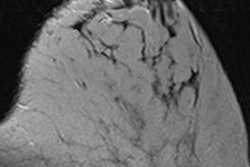
Clinical trials for a high-resolution breast CT scanner will begin in Germany in early 2015, according to a talk by Willi Kalender, PhD, at the International Symposium on Multidetector-Row CT (MDCT). The hope is that the technology will outperform full-field digital mammography and breast tomosynthesis at equivalent dose levels.
Kalendar, professor and chairman of the Institute of Medical Physics at Friedrich-Alexander-University of Erlangen-Nuremberg in Germany, delivered an update on the status of clinical trials for breast CT technology that uses direct-conversion cadmium telluride (CdTe) detector material and photon-counting electronics with 100-micrometer detector element size.
 Willi Kalender, PhD.
Willi Kalender, PhD.
The scanner can outperform digital mammography and breast tomosynthesis with respect to spatial resolution and in detecting microcalcifications and soft-tissue lesions at an average glandular dose below 5 mGy, he said.
"We've developed a new technology for breast cancer diagnosis based on CT, and we are very close to clinical testing now," he said. "Based on simulations, we believe we can image microcalcifications down to 100 micrometers, as well as smaller soft-tissue lesions than we would see in mammography, at similar dose levels."
Kalender and colleagues published details about the technology a few years ago in European Radiology (January 2012, Vol. 22:1, pp. 1-8).
In his talk at MDCT 2014, he highlighted key points from this previous research:
- The technology allows for diagnosis of both microcalcifications and soft tissue in one acquisition.
- Microcalcifications of 100 to 150 micrometers are resolved.
- Soft-tissue lesions down to 2 mm in diameter can be discerned.
- Dose levels of 2 mGy to 4 mGy conform to screening constraints.
- The device design is similar to a biopsy table, with the woman lying prone; it will allow for biopsies to be performed as well.
Trials were initially planned for 2013, but they have been delayed due to clinical study regulations, according to Kalender. The tests will be conducted at Friedrich-Alexander-University of Erlangen-Nuremberg and the University of Aachen. They will include a physics-based comparison of the performance of 2D projection imaging, tomosynthesis, and 3D CT imaging, as well as an assessment of each modality's spatial resolution, dose requirement, and ability to detect cancer structures, Kalender said.
"I'm very optimistic that this dedicated CT technology will improve breast cancer diagnosis," he concluded.




















